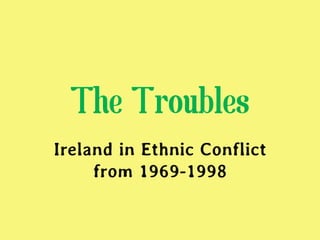
Hist390pres
- 1. The Troubles Ireland in Ethnic Conflict from 1969-1998
- 2. Background Why did the “troubles” even occur? Why so much violence? Was it because of…
- 3. Religious Differences? Ireland has always been Protestant versus Catholic. Although Northern Ireland belongs to the UK (and therefore, is mainly Protestant, counties within N. Ireland are still predominantly Catholic.
- 4. The Home Rule Issue? Southern Ireland had been trying for years to obtain their own government in Dublin, but under British authority.
- 5. The Desire for Complete Irish Independence? Southern Ireland became the Republic of Ireland. They got their independence, but can supporters living in Northern Ireland unify both Irelands together?
- 6. The Desire For Ireland to Stay Loyal to the Crown? Unionists: We choose to support British Parliament & the Crown.
- 7. Civilian Deaths by Year 1970-1982* 300 1970-1982 250 200 Civilian Deaths by Year 150 100 50 0 1970 1971 1972 1973 1974 1975 1976 1977 1978 1979 1980 1981 1982 *McKittrick & McVea had a range from 1966-2001, but the 1970s to the Hunger Strike of ‘81 were the peak of the Troubles.
- 8. Responsibility for Deaths from Making Sense of the Troubles by David McKittrick & David McVea 2500 2000 1500 1000 500 0 Groups Involved Nationalists Loyalists All Security Forces Others Nationalists were responsible for the brunt of the deaths during the Troubles, but Loyalists were not innocent. All security forces meant auxiliary police groups, like the pro-Loyalist B-Specials.
- 9. Momentum Battle of the Bogside: 12-14 August 1969 Derry/Londonderry, Northern Ireland
- 10. • November 1969: Ulster Defence Regiment replaces B-Specials 1969-1973 • July 1970: All marches, including Drumcree, are banned. • February 1971: IRA shoots Robert Curtis, the first serving soldier to die in the Troubles. A Brief • January 1972: Bloody Sunday redux—13 men shot in Derry/Londonderry by Timeline army. • July 1972: Bloody Friday—22 IRA bombs kill nine civilians and numerous are injured. • December 1973: Sunningdale…
- 11. What was Sunningdale? Sunningdale was an attempt to create a power-sharing government between the Ulster Unionist party, the nationalist Social Democratic and Labour Party, and the Alliance party. However, it ended as quickly as it started, as it was met with major opposition from the IRA and from the Protestants, for the IRA wanted total victory and the Protestants thought it’d end up helping form a fully united Ireland.
- 12. The Ulster This protested the assembly Workers’ vote regarding the complete endorsement of Sunningdale. Council Strike: This strike involved Unionist paramilitary groups like the May 1974 UDA. Electricity output declined and work places were forced to close. The new power-sharing executive had no power over the strikers and soon, the strikers gained the upper hand. Two weeks later, Faulkner conceded , the strike ended and Sunningdale was no more.
- 13. The Origins of Criminalization: 1976 As paramilitary actions became more violent after Sunningdale fell through, increasing numbers of paramilitary members from both sides were jailed. Typically detained at Long Kesh prison, paramilitary members had one thing ordinary prisoners did not… Special Category Status (1972): This meant they were political prisoners and were treated to certain privileges ordinary prisoners were not. They didn’t take orders from prison guards but their William Whitelaw, at the time Secretary Officer Commanding (OC), wore normal of State for Northern Ireland, gave this clothes and not a prison uniform and were status to paramilitary prisoners. exempt from doing prison work.
- 14. Regrets: Criminalization, 1976 Whitelaw, in retrospect four years later, chooses to revoke it. What does this mean for paramilitary prisoners now? They are now ordinary prisoners and their privileges do not exist. Their crimes are not classified as being “politically” motivated.
- 15. What Would A Paramilitary Do? Revenge! They went to the extreme to get their status back. Paramilitary strikes Early Strikes, included: 1976-1980 1976: Going “on the blanket.” What would a paramilitary do? This protest started it all; when newly detained Revolt, of course. prisoners were given their uniform, they refused to wear it and leave their cell. They only had one Housed in three specific jails thing to wear…the blankets on their beds. By throughout Northern Ireland, 1978, 300 prisoners were “on the blanket.” paramilitary prisoners planned numerous strikes in order to get their political status back. 1978: The “Dirty” Protests The prisoners didn’t have enough support from the outside, so they stepped it up a bit in 1978. Check out this map to see What started out as a “no-wash” protest more information about the culminated into the dirty protest. They refused to jails, and their location leave their cells and as a result, chamber pots got throughout Northern Ireland. full and caused this…
- 16. Yes, that is what you think it is on the wall. Prisoners had one way to get rid of their waste in order to avoid being beaten up by the screws (prison guards) if they dared leave their cells. This strike kept going on until 1980, when they decided to go even more extreme…
Hinweis der Redaktion
- Here I wish to link to a map of the evacuation plan by the British army overlaid on a map of the Derry/Londonderry area, but right now, Google Earth is giving me some issues.